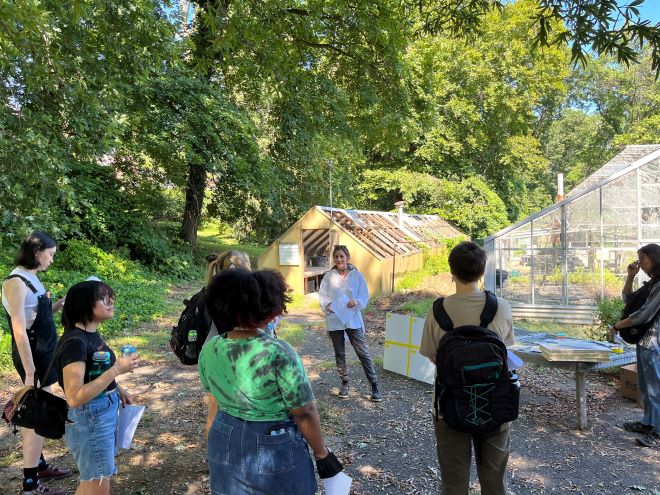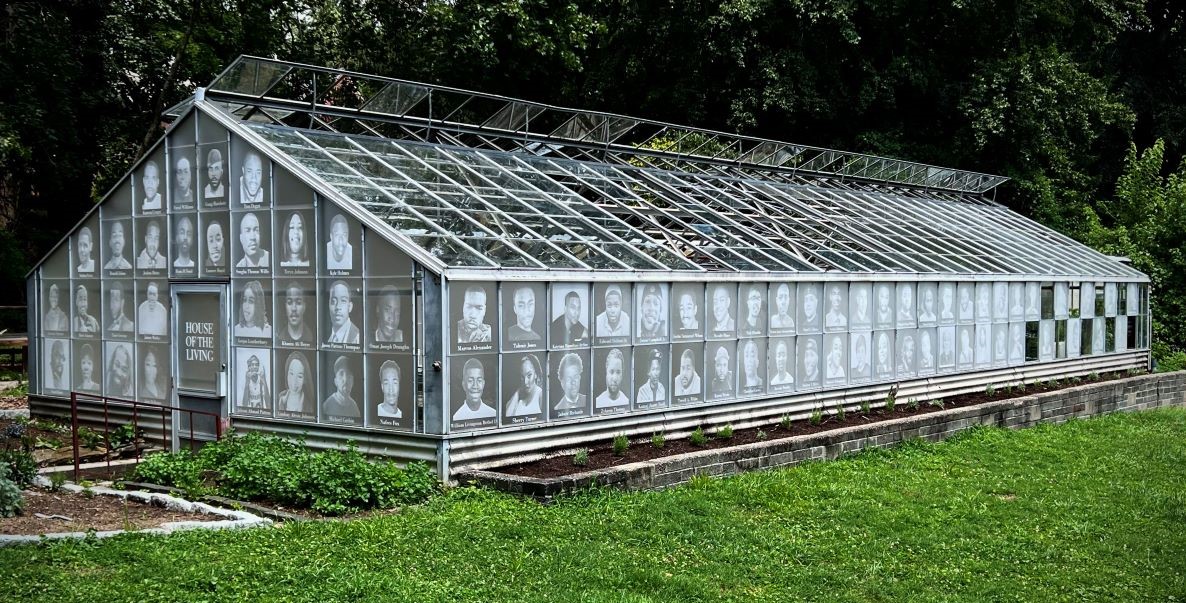At one point, the greenhouse in Elkins Park had been abandoned for so long, the overgrowth inside hung from the ceilings and spilled out of missing window panes, obscuring sunlight from breaking through. Now, light floods through its glass again, panels etched with the faces of gun violence victims, repurposed into a project that calls itself House of the Living.
The name draws inspiration from The Book of the Living in Octavia Butler’s Parable of the Sower. In the novel, the protagonist has created a belief system from which she spreads word of central tenets — such as every person’s ability to effect change, the importance of community, and revisioning a better tomorrow. House of the Living founder and Associate Professor of Art at Swarthmore College, Ron Tarver, says the idea of turning the greenhouse into a memorial for gun violence victims came to him while walking by it with his dog Winston one day during the pandemic.
In the middle of Covid, there was nowhere Tarver could immediately bring the idea. But about a year later, while walking by the site again, he ran into Brandon Ritter, Chief Operating Officer of FarmerJawn & Friends Foundation Fund, who was working on the greenhouse. The food justice nonprofit had leased five acres of land on the Elkins Estate in Elkins Park where House of the Living is located. From that fortuitous meeting, Tarver’s idea began to take shape.
“For the families it’s more alive. For them it’s like, it’s a spirit and the being of their families is still alive. It’s a very different experience than going to the cemetery. It’s as though their presence is still here.” -Laura Oliver
Tarver found a partner in FarmerJawn, the CSA (community-supported agriculture) farm, as well as EMIR Healing Center, a nonprofit that provides grief counseling and trauma healing services to families who have lost loved ones to homicide. When the project is finished — it is still in its first phase — FarmerJawn will operate it as an active greenhouse. Also, Tarver and Laura Oliver, the site’s project manager, plan to rework the landscape nearby to include seating and ADA-compliant infrastructure to host programming for the families EMIR works with, like wellness workshops and farming.
The group’s collaborative work has been driven by a shared purpose: creating a judgment-free space for people who have lost someone to find solace and be with their loved one where they can heal from, rather than revisit, their trauma.
Portraits of victims are engraved onto 24 by 24-inch plexiglass panels; the house will be filled with 410 panels at its completion. “That’s how many it holds. But it’s [also] coincidental that that approximates the number of homicides in Philadelphia in an average year,” says Tarver.
Jody Joyner, Assistant Professor of Art at Swarthmore, has been instrumental in transforming the greenhouse into the memorial. Tarver asked if she would take part in the project to offer her expertise in 3D design; she happened to be teaching a class called “Sculpture and the Environment” and incorporated the greenhouse project into the first part of the semester. Students were so engaged that they decided to continue throughout the whole semester.

So far, the greenhouse features about 90 portraits created by the Swarthmore students, who burned the panels into acrylic in Swarthmore’s MakerSpace. Student artists have created another 11 panels, which will soon be installed as well.
I first visited House of the Living on a Friday morning in mid-October. Taking back roads to arrive at the beautiful natural surroundings afforded by Elkins Park, it was clear that the environment is what makes it such a peaceful spot for families to visit and stay for a while. “You barely hear cars, but you hear all the birds,” says Oliver.
The front face of the greenhouse is completed, including the entrance, which reads House of the Living, and most of the right side. Tarver says the portraits are meant to depict victims just as they were in life. They capture the subject in a moment of joy, or candidly, not quite holding a pose but caught as if someone might have told them to look right over at the camera. “They’re portraits that sort of best describe who that person was,” Tarver says.
While walking around the walls of the house, what stands out is that the portraits are still, though not solemn. “For the families it’s more alive. For them it’s like, it’s a spirit and the being of their families is still alive. It’s a very different experience than going to the cemetery. It’s as though their presence is still here,” Oliver says.
Approaching victims’ families with compassion
When it came to getting in touch with families who might have been interested in participating in House of the Living, the team connected with EMIR Healing Center. Chantay Love, Co-Founder and President of EMIR, says that in getting families on board, it was important, above all, to move at a pace with which they felt safe and comfortable. While Swarthmore students were requesting photos for engraving the panels, they held trauma-informed interviews with the families with support from EMIR counselors. Love says, “They had to have an awareness of what families and individuals go through when they lose someone. So that’s what some folks may not see is a big thing — you asking a family, So, well, tell me what happened. That’s traumatizing. And you don’t always need the story to understand or have compassion for a person.”
“It’s more about celebrating a life that now is lost, and how that life can continue to live on through the plants that we’re growing, through the sun that’s shining through these panes of glass that are growing new plants, and then these plants are being put out into a field so that they can nourish a community.” –Christa Barfield
Love says doing the work of healing after such tragedies is also about changing a larger landscape. “How do we hopefully heal a community and heal a city after something so tragic has happened?” she asks. Part of it is addressing the state of our disinvested communities. It’s a question Christa Barfield, CEO of FarmerJawn, is helping to answer through her organization’s work against food injustice. As a CSA, FarmerJawn provides workforce development and agricultural education through its nonprofit arm, FarmerJawn & Friends Foundation Fund; it strives to impact the social, environmental, and physical wellbeing of places where food scarcity exists, which are also predominantly communities of color.
Partnering with House of the Living is a natural extension of FarmerJawn’s motto, “Agriculture is the culture.” Barfield says, “For this particular project we have an ability to be able to revere these individuals who lost their lives to gun violence, regardless of the situation and who they were and things that they’ve done, none of that matters here — it’s more about celebrating a life that now is lost, and how that life can continue to live on through the plants that we’re growing, through the sun that’s shining through these panes of glass that are growing new plants, and then these plants are being put out into a field so that they can nourish a community.”
House of the Living is open to the public daily from dawn until dusk. Find it at Beech Avenue and Cedar Lane, Elkins Park, houseoftheliving.net.
![]() MORE ON GUN VIOLENCE IN PHILADELPHIA
MORE ON GUN VIOLENCE IN PHILADELPHIA




